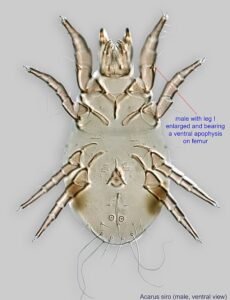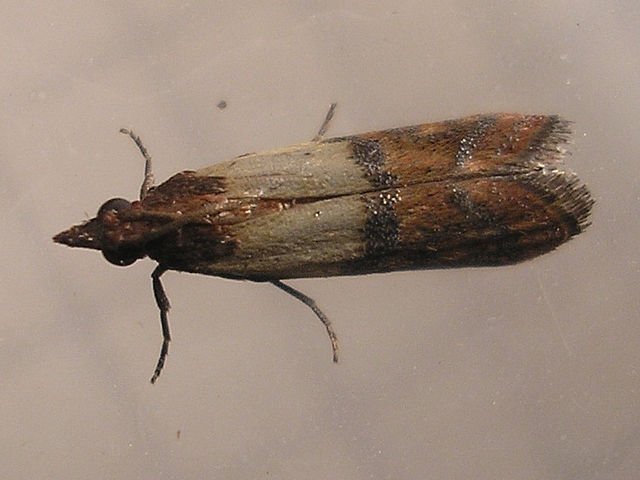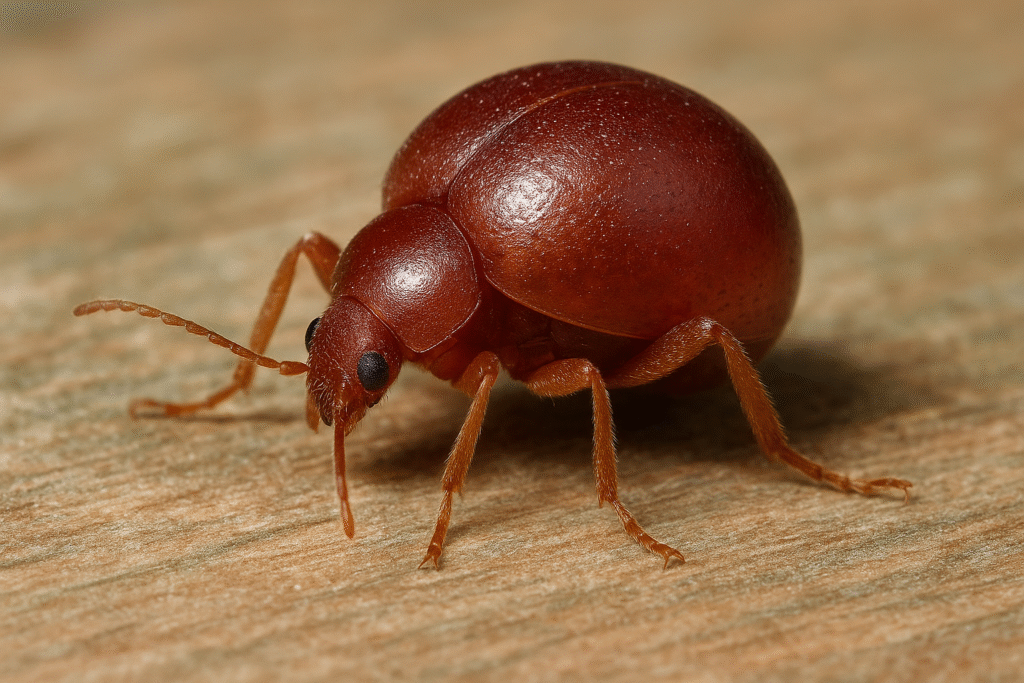Grain Mites (Acarus siro): The Hidden Pests of Stored Food

If you ever opened a bag of flour, cereal, or animal feed and found it covered in fine white dust that seemed to move — congratulations, you’ve met the grain mite (Acarus siro).
These microscopic pests are a nightmare for food storage, bakeries, and animal feed facilities. You often don’t notice them until the infestation explodes and the food takes on a sweet, musty smell and clumps together.
In my career as a pest control professional, I’ve seen many storerooms ruined not by pantry beetles, flour moths (Ephestia kuehniella), or weevils (Sitophilus spp.) as you might expect — but by these almost invisible mites. They spread fast, lay eggs everywhere, and thrive in humidity, turning stored food useless in just a few days.
Unlike booklice (Liposcelis spp.) or grain beetles (Oryzaephilus surinamensis), which are visible and easier to detect, grain mites hide in dust, crevices, and packaging seams — making them a silent but costly pest.
Understanding them is the first step to controlling them effectively.
Identification
Grain mites are tiny, white-to-pale-beige arthropods, belonging to the Acaridae family. Adults are only 0.3 to 0.5 mm long, barely visible to the naked eye. Under a microscope, they look translucent, with hair-like setae and oval bodies.
Key identification points:
Color: White, creamy, or slightly brownish when mature.
Movement: Slow-moving but highly active in humid conditions.
Smell: Heavy infestations often create a distinct sweet, moldy odor.
Dust appearance: Large colonies look like a fine powder that moves — this is often how people first notice them.
Grain mites are commonly mistaken for flour dust, mold spores, or even booklice (Liposcelis spp.), but unlike those, they thrive directly on organic food matter.
Biology and Ecology
The life cycle of the grain mite is rapid — about 8 to 21 days, depending on temperature and humidity.
Egg: Females lay up to 800 eggs in clusters on food materials.
Larva and Nymph: The young feed on flour, bran, or other organic materials.
Hypopus Stage: A dormant form that allows them to survive unfavorable conditions (dryness, cold, or lack of food).
Adult: Fully developed mites continue feeding and reproducing rapidly in warm, moist environments.
Optimal conditions are:
Temperature: 20–27°C (68–80°F)
Humidity: Above 65% relative humidity
They stop reproducing below 15°C or in dry environments — which is why good ventilation and moisture control are key in storage management.
Global Distribution
Grain mites are cosmopolitan, found in nearly every region where humans store food.
North America: Common in grain silos, bakeries, and food-processing plants.
Europe: Frequent problem in old warehouses and domestic pantries with poor humidity control.
Asia: Widespread in rice and spice storages.
Australia: Major issue in livestock feed and pet food factories.
Wherever humidity meets organic material, grain mites appear. Even imported goods can introduce infestations to clean facilities.
Risks and Damage
Grain mites cause both economic and health-related problems.
Economic Impact
Contaminated food becomes unsellable due to visible movement and odor.
Mites spread rapidly between stored goods, ruining entire batches.
Food businesses may face recalls or shutdowns from inspections.
Health Risks
Inhalation of mite fragments can cause allergic reactions, itching, or respiratory irritation (“grocer’s itch”).
Infested feed can cause animal dermatitis and reduced appetite.
Dead mites and waste contribute to dust contamination.
Even though they don’t bite humans, heavy infestations in bakeries and homes often lead to skin irritation and psychological discomfort — people feel “crawling” sensations from tiny mites they can’t see.
Signs of Infestation
Early detection is hard, but these clues can reveal their presence:
Fine white dust that seems to move on food surfaces.
Sweet, musty odor from flour, grains, or feed.
Sticky or clumped flour that doesn’t flow normally.
Visible mites crawling on walls or lids in humid storage rooms.
Workers reporting itching or irritation during handling.
The problem often starts small and explodes in a few days if humidity stays high.
Control Methods
When dealing with grain mites, environmental control is more effective than chemicals.
1. Lower Humidity
Reduce relative humidity below 55%. Mites cannot reproduce in dry conditions.
Use dehumidifiers, increase airflow, and avoid storing food near wet areas.
2. Clean Thoroughly
Empty and vacuum infested storage bins, cracks, and corners. Dispose of contaminated food immediately — never mix old with new stock.
3. Freeze or Heat Treatment
Freeze small quantities at –18°C for 48 hours, or
Heat at 50–55°C for 2 hours to kill all life stages.
4. Monitor Continuously
Install sticky traps or white monitoring cards near storage shelves to detect movement early.
5. Use Insecticides or Miticides (Professional Only)
When humidity and food residues can’t be fully controlled, a licensed pest control technician can apply residual products based on pyrethrins or inorganic dusts (e.g., diatomaceous earth).
These should be applied only after cleaning, and never directly on food or packaging.
Advanced Approaches
In industrial pest management, controlling grain mites means managing the entire microclimate:
Integrated Pest Management (IPM): Combines sanitation, monitoring, temperature control, and periodic fogging under strict safety protocols.
Hermetic storage systems: Air-tight silos that limit oxygen and moisture, stopping mite growth.
Vacuum drying: In modern grain facilities, air-drying silos prevent mite and mold infestations simultaneously.
Digital monitoring: Smart sensors can track humidity and temperature, alerting operators before mites appear.
For small businesses like bakeries or pet food shops, frequent cleaning and rotation of old stock are still the best tools — and cost almost nothing.
Cultural and Historical Context
Humans have battled stored product mites since the dawn of agriculture.
Archaeological finds show infested grain jars in ancient Egyptian tombs and Roman granaries. These early civilizations already knew that dampness ruined their crops — they just didn’t know microscopic mites were behind it.
In the early 1900s, the rise of industrial milling and long-term storage brought global outbreaks of Acarus siro infestations. Entire shipments of wheat and barley were destroyed before refrigeration and modern ventilation systems became standard.
Today, grain mites still cause millions of dollars in food loss worldwide each year. The battle continues — just on a smaller, microscopic scale.
FAQ
1. Are grain mites dangerous to humans?
Not directly, but they can cause allergic reactions, skin irritation, and respiratory problems in sensitive people.
2. Can I see grain mites with my eyes?
Barely. They look like tiny moving white dots or powder on stored food.
3. What do grain mites eat?
Flour, grains, cereals, pet food, dried fruits, and even cheese or yeast.
4. How fast do they reproduce?
Under warm, humid conditions, they can double their population in less than a week.
5. Can I use insecticides myself?
No — insecticides rarely work well on mites and can contaminate food. Focus on cleaning, drying, and temperature control first.
6. Do grain mites bite humans or pets?
No, but they may cause irritation or itching if they come into contact with skin.
7. How can I prevent them long-term?
Keep humidity low, store food in airtight containers, and rotate stock regularly.
Final Thoughts
Grain mites are one of those invisible enemies that can ruin food before you even realize they’re there. In my experience, most infestations don’t start because of neglect — they start because of humidity. One small leak, poor ventilation, or bag of flour stored too long can trigger an outbreak that spreads through a whole storeroom.
The key to control is prevention, not poison. Keep the air dry, clean regularly, and never store old and new food together. Once mites appear, throwing away infested products and sanitizing surfaces is the only real solution.
For food industries, Integrated Pest Management (IPM) remains the best approach — combining strict hygiene, humidity monitoring, and regular inspections by trained professionals. For homeowners, simple steps like airtight containers, dry shelves, and good airflow can save a lot of money and frustration.
Grain mites remind us of a basic truth in pest control: small pests often create big problems. But with discipline and knowledge, they can be completely prevented.
Learn more about other Stored Product Pests
Disclaimer
This article is for informational purposes only. Pest control laws and approved chemicals vary by country. For best results and legal safety, we strongly recommend contacting a licensed pest control professional in your local area. Always make sure that the pest control technician is properly certified or licensed, depending on your country’s regulations. It’s important to confirm that they only use approved products and apply them exactly as instructed on the product label. In most places in Europe, UK, or USA, following label directions is not just best practice—it’s the law.
Author
Nasos Iliopoulos
BSc Agronomist & Certified Pest Control Expert
Scientific Director – Advance Services (Athens, Greece)
Licensed Pest Control Business – Ministry of Rural Development & Food (GR)
References
Kentucky University - Grain Mites
Kansas University - Winter Grain Mite


